If you’re planning to launch or upgrade your online store, chances are you’ve already realized how tricky it can be to pick the right platform, especially between popular names like WooCommerce vs Zen Cart.
On paper, these two seem to tick many of the same boxes: both are open-source, both give you the freedom to customize, and both can run a fully functional eCommerce business. Given their similarities, how do you know which one is truly the better fit for your business?
And that’s exactly what we’re here to unpack! In this article, we’ll compare WooCommerce and Zen Cart across all the key criteria that matter most:
- eCommerce features
- Ease of use
- Themes & customization options
- Plug-ins/Integrations
- Hosting requirements
- SEO & marketing
- Scalability and performance
- Security
- Support and community
- Pricing
Let's jump in!
WooCommerce vs Zen Cart: A Quick Overview
Before we go into our Zen Cart vs WooCommerce feature-by-feature comparisons, let's first have a quick look at what these solutions actually are at their core:
About WooCommerce
WooCommerce, with over 6,1 million users, is a free plugin built on WordPress, the world's most popular content management system. That means it inherits all of WordPress's flexibility, theme options, and plugin ecosystem.
With WooCommerce, you get a lightweight foundation that can be expanded with thousands of extensions for payments, shipping, marketing, SEO, and more. It's highly accessible to beginners thanks to its seamless WordPress integration, but still powerful enough to support larger businesses when paired with professional hosting and premium tools.
(Read more: WooCommerce review)
WooCommerce Pros | WooCommerce Cons |
Free to install and easy to set up within WordPress | Heavy reliance on plugins can increase costs over time |
Massive ecosystem of themes, plugins, and integrations | Performance depends heavily on hosting and plugin quality |
Regular updates and strong security community | Limited built-in SEO and marketing tools |
User-friendly interface with setup wizard | Advanced features often require paid extensions |
Scales well with proper optimization | Ongoing maintenance can be time-consuming |
About Zen Cart
Zen Cart is an open-source, self-hosted eCommerce platform that has been around since 2003 and is currently used by 39,000+ online stores.
Unlike WooCommerce, it isn’t tied to a CMS, but rather a standalone shopping cart solution. Zen Cart emphasizes control and configurability, which gives technically proficient users the ability to fine-tune everything from server settings to database performance. However, this power also comes with complexity, as Zen Cart’s setup and customization rely more on coding knowledge.
Zen Cart Pros | Zen Cart Cons |
Completely free to download and install | Steep learning curve for beginners |
Strong control over server, database, and code | Outdated interface compared to modern platforms |
Supports a wide range of stock and shipping configurations | Limited built-in SEO and marketing tools |
Large library of free community-built extensions | Quality of extensions is inconsistent |
Scales very well with expert optimization | Customer support is minimal |
WooCommerce vs Zen Cart: Which Is Better?
After examining all the major categories, we can say that WooCommerce emerges as the overall stronger choice. Its integration with WordPress makes it much easier to use and customize, and the sheer size of its ecosystem gives store owners more flexibility to grow and adapt!
But, of course, Zen Cart still holds value for highly technical merchants who want deep control and can manage their own server optimizations, as shown in this WooCommerce vs Zen Cart table below:
Feature | WooCommerce | Zen Cart | Winner |
eCommerce Features | Wide range through official + third-party extensions | Solid basics, fewer official extensions | WooCommerce |
Payments | WooPayments and 80+ gateways, supports wallets | Core modules + community plugins, less polished | WooCommerce |
Shipping | 120+ official plugins, flexible | 60+ modules, strong built-in customization | WooCommerce |
Inventory | Basic but user-friendly, extendable with plugins | Advanced settings, but technical | Tie |
Ease of Use | Simple setup via WordPress, setup wizard | Manual installation, higher barrier | WooCommerce |
Themes & Customization | 110+ official themes, hooks, filters | 20+ templates, coding required for changes | WooCommerce |
Plugins/Integrations | 1,100+ vetted extensions | 2,200+ free extensions, mixed quality | Tie |
Hosting | Self-hosted, wide choice of providers | Self-hosted, wide choice of providers | Tie |
SEO & Marketing | 200+ plugins, integrates with WordPress SEO | 130+ plugins, no dedicated SEO section | WooCommerce |
Scalability & Performance | Easier for small to medium stores | Higher ceiling with technical expertise | Zen Cart |
Security | Large security community, frequent updates | Depends on user skill, slower patches | WooCommerce |
Support & Community | Extensive docs, forums, onboarding help | Limited docs + community forum only | WooCommerce |
Pricing | Flexible, scalable costs | Predictable but less flexible | WooCommerce |
Keep scrolling for further breakdown!
eCommerce Features (WooCommerce wins)
The Verdict
WooCommerce vs Zen Cart appear fairly even at first glance if we only look at their built-in capabilities. However, when it comes to how they expand beyond their core features, WooCommerce is the clear winner for its broader ecosystem of official and third-party extensions that are consistently maintained.
To understand their performances, let's break them down across three essential areas of eCommerce: payments, shipping, and inventory management.
Payment
For payments, WooCommerce offers a frictionless experience through WooPayments, its native solution built by Automattic and powered by Stripe. Merchants can accept all major credit and debit cards while also enabling digital wallets like Apple Pay and Google Pay without the need for extra extensions.
Better yet, WooPayments further supports regional options such as iDEAL, Bancontact, and Giropay, which makes it an extremely versatile choice for international stores. On top of that, the WooCommerce marketplace provides more than eighty additional gateway extensions, so you can enjoy even more extensive flexibility to meet customers' preferences!

Meanwhile, Zen Cart also supports popular gateways like PayPal, Stripe, Braintree/NMI, and Opayo.
Still, most of its options come through core modules or community-developed plugins. There are over 250 of them available, but keep in mind that their quality and reliability understandably differ, as Zen Cart itself does not develop these plugins. Not to mention, features like Apple Pay or Google Pay are not built-in and require configuration through a compatible processor.

Shipping
Now, let's look at shipping.
Zen Cart's built-in tools are surprisingly versatile for a platform of its age. Merchants can create shipping zones tailored to specific regions, add precise product dimensions to improve rate calculations, and set conditions for free shipping with relative ease.
Better yet, for those willing to get technical, Zen Cart even allows further customization through SQL commands, and its catalog of more than sixty shipping modules adds extra flexibility. Many of these modules automatically disable themselves when their conditions are not met, which prevents your customers from seeing irrelevant options at checkout.
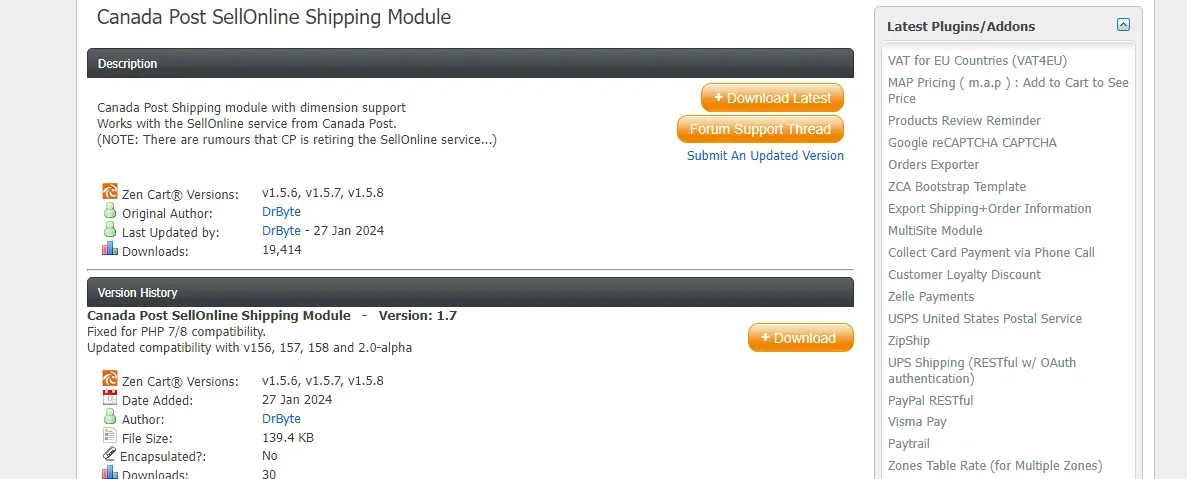
On the other hand, WooCommerce starts from a slightly simpler foundation, as it offers only flat rate, free shipping, and local pickup by default.
At first, this may look more limited than Zen Cart, but don't forget that WooCommerce is designed to grow through extensions at the end of the day! With over 120+ official shipping plugins available, merchants can quickly add everything from carrier-calculated rates to advanced table rules and access-point pickups. Basically, the system can be shaped to fit virtually any shipping strategy.
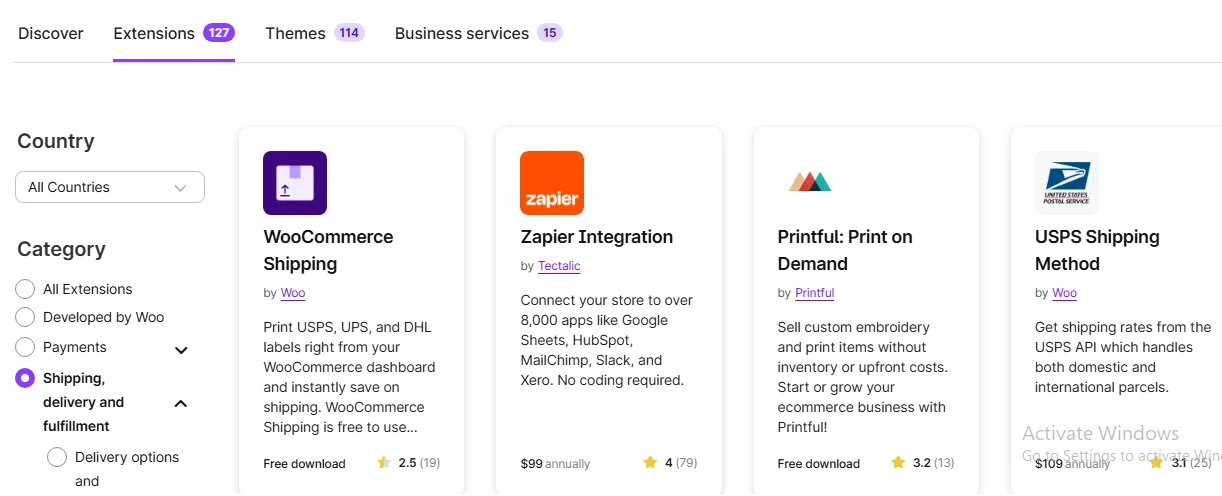
Inventory management
Inventory management shows perhaps the clearest difference in philosophy between WooCommerce vs Zen Cart.
Zen Cart takes a configuration-heavy approach and offers a wide range of stock settings within its admin panel. Merchants can check stock levels before checkout, decide whether to allow purchases when items are out of stock, set reorder thresholds, and display “Sold Out” notices automatically. These tools cover the basics but often require a technical mindset, as the options are largely presented as configuration keys rather than user-friendly dashboards:
Key | Description |
STOCK_CHECK | Verify if enough stock is available before checkout. |
STOCK_LIMITED | Reduce stock count automatically when orders are placed. |
STOCK_ALLOW_CHECKOUT | Decide whether customers can complete checkout even if stock is insufficient. |
STOCK_MARK_PRODUCT_OUT_OF_STOCK | Visually mark products as out of stock for customers. |
STOCK_REORDER_LEVEL | Set the threshold for when stock should be replenished. |
SHOW_PRODUCTS_SOLD_OUT | Control visibility of out-of-stock items (hide or show with “sold out” status). |
DISABLED_PRODUCTS_TRIGGER_HTTP200 | Configure how search engines treat disabled products (200, 404, or 410). |
SHOW_PRODUCTS_SOLD_OUT_IMAGE | Replace the “Add to Cart” button with a Sold Out image when stock is gone. |
ENABLE_DISABLED_UPCOMING_PRODUCT | Manage how upcoming products are activated once their availability date arrives. |
QUANTITY_DECIMALS | Allow use of decimal places for stock quantities |
WooCommerce, meanwhile, integrates inventory management directly into the order lifecycle and turns inventory management into a natural part of running the store. Still, most settings are fairly basic, so you should consider adding extensions over time as your store keeps growing:
Order Status / Setting | Description |
Pending Payment | Order created but no payment received yet (common with manual/bank transfers). |
Processing | Payment received; stock is deducted, and items are being prepared for shipment. |
On Hold | Order is waiting for confirmation (stock may be reserved). |
Completed | Order fulfilled and shipped; stock adjustments are finalized. |
Cancelled | Order cancelled by customer or admin; no further action required. |
Refunded | Order partially or fully refunded; stock can be restored if desired. |
Failed | Payment attempt unsuccessful; stock is not deducted. |
Backorders | Optional toggle to allow purchases even if stock is insufficient. |
Stock Display | Inventory levels and stock status visible both in the admin and on product pages. |
Ease of Use (WooCommerce wins)
The Verdict
Both WooCommerce vs Zen Cart are ultimately manageable once you learn their systems. However, WooCommerce still benefits more from its deep integration with WordPress, which makes installation and setup almost effortless.
Let's have a closer look at WooCommerce vs Zen Cart here:
Zen Cart's ease of use
We must say the initial experience with Zen Cart can be challenging.
Although third-party installers like Softaculous or Installatron exist to simplify setup, Zen Cart's official documentation explicitly advises against using them. That leaves new users with manual installation as their only reliable path forward.
Needless to say, for those unfamiliar with server environments, creating databases or working with FTP, this step is obviously intimidating and time-consuming! It's a higher barrier to entry, and one that may frustrate beginners before they even reach the dashboard.
Fortunately, once the software is running, Zen Cart starts to feel more approachable.
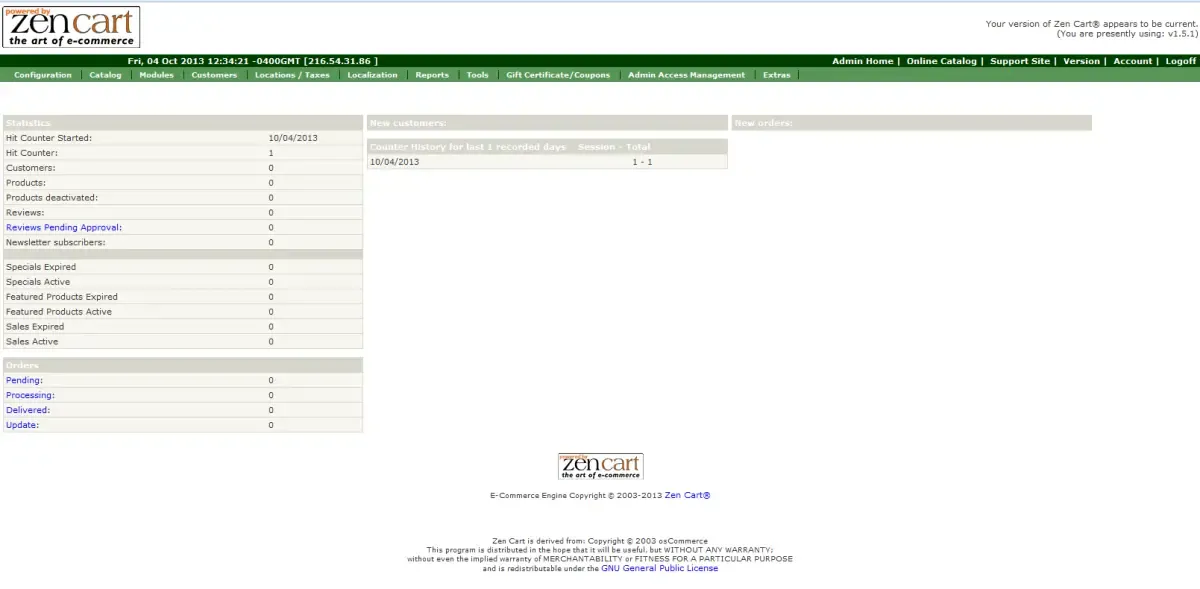
Sure, the design is somewhat old-fashioned compared to modern platforms, but it makes up for that with efficiency. The admin panel is structured around a clear top navigation bar, with dropdown menus that neatly organize related options. Better yet, instead of forcing you to dig through multiple layers of configuration, most of the important settings are accessible from a single screen, which helps ensure smoother day-to-day management.
WooCommerce's ease of use
Meanwhile, WooCommerce removes nearly all friction at the start. Since it operates as part of the WordPress ecosystem, all you need to do for installation is navigate to your plugin library, search for “WooCommerce,” and click install. Within moments, it's active on your site!

From there, WooCommerce welcomes you with a guided setup wizard that handles the essentials (store information, product types, payments, and shipping), ensuring that even newcomers can be selling quickly without having to piece everything together manually. Plus, its menus and dashboard sections are integrated directly into the WordPress admin, so anyone with even a basic knowledge of the platform will feel immediately comfortable.
Themes & Customization Options (WooCommerce wins)
The Verdict
Between WooCommerce vs Zen Cart, the latter mostly leans on manual code edits and overrides for even small design tweaks, which can be empowering for developers but daunting for non-technical users. WooCommerce, by contrast, offers both ready-made themes anđ a deep framework of hooks, filters, and template overrides.
This section will shed further light on the difference between WooCommerce vs Zen Cart:
Zen Cart's customization
Setting up a Zen Cart store usually starts with choosing a theme, and there are about 20+ options available on Zen Cart, plus third-party themes across popular marketplaces like TemplateMonster.

Once a theme is installed, you can make some minor adjustments using the built-in settings – for example, resizing side boxes, removing the search bar in the header, or changing how categories and buttons appear.
Unfortunately, these convenient adjustments only scratch the surface. The moment you want to go beyond those basics, Zen Cart's reliance on manual coding becomes clear. Even seemingly simple changes, such as altering fonts or color palettes, usually require editing stylesheets in a text editor!
Needless to say, for merchants with coding skills, this level of control is powerful, since virtually every element of the site can be tailored to preference. But for those without technical expertise, the steep learning curve can be rather discouraging.
WooCommerce's customization
How about WooCommerce?
Since it's built on WordPress (as mentioned earlier), it integrates seamlessly with WordPress themes, though not every theme is fully compatible. Hence, to avoid layout issues, WooCommerce recommends using a theme specifically designed for the WooCommerce platform. Fortunately, the options here are abundant: more than 110 official themes are available, with several free ones and premium designs typically priced between $40 and $100 per year. Merchants can get a professional look quickly, often without touching a single line of code.

And that's not all! For merchants and developers who want more control, WooCommerce provides robust options for customization. You can override template files within your theme to adjust the layout of product pages, checkout flows, or category displays. Even more powerful are WooCommerce's hooks and filters, which let you safely inject or modify functionality at specific points in the shopping journey. Be it adding content before the “Add to Cart” button or changing how orders are processed, WooCommerce makes it possible to do so without ever altering the core files.
Plug-ins/Integrations (A tie)
The Verdict
Plugins and integrations are where both WooCommerce vs Zen Cart shine, but in very different ways. Zen Cart thrives on community contributions; WooCommerce, in contrast, offers a smaller but carefully curated marketplace where quality and security are prioritized.
As one platform excels in quantity and the other in quality, it's fair to call this category a tie. Let's look at how each platform between WooCommerce vs Zen Cart approaches integrations in practice.
Zen Cart's plugins
All in all, Zen Cart draws much of its strength from the passion of its community. Over the years, users and developers have built more than 2,200 extensions, neatly grouped into fifteen main categories.
This vast library means that no matter what functionality you are looking for, there's likely an extension that can do the job. The fact that most of them are completely free adds even more appeal!
Exploring this library is also straightforward thanks to Zen Cart's filtering system. You can sort extensions by name, release date, number of downloads, or even the last time an extension was downloaded. It's also possible to browse by developer or by community rating, which helps surface the most reliable tools. And once you click on an extension, Zen Cart even provides its full update timeline, so you can see how actively it has been supported.
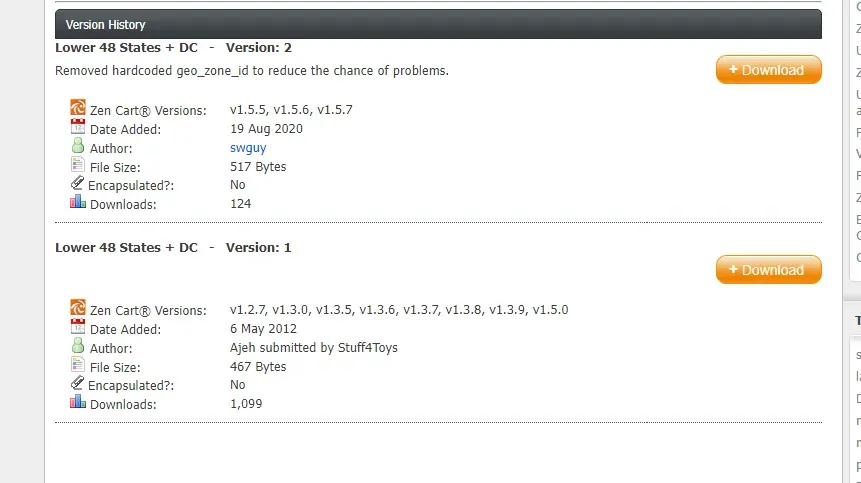
That said, the open nature of this system has its downsides. Because so many extensions are community-built, quality is uneven, and overlapping functionality is common. Simply put, merchants gain freedom, but they must also take on the responsibility of checking stability before installation.
WooCommerce's plugins
WooCommerce, on the other hand, lists just over 1,100 extensions (about half the number Zen Cart offers).
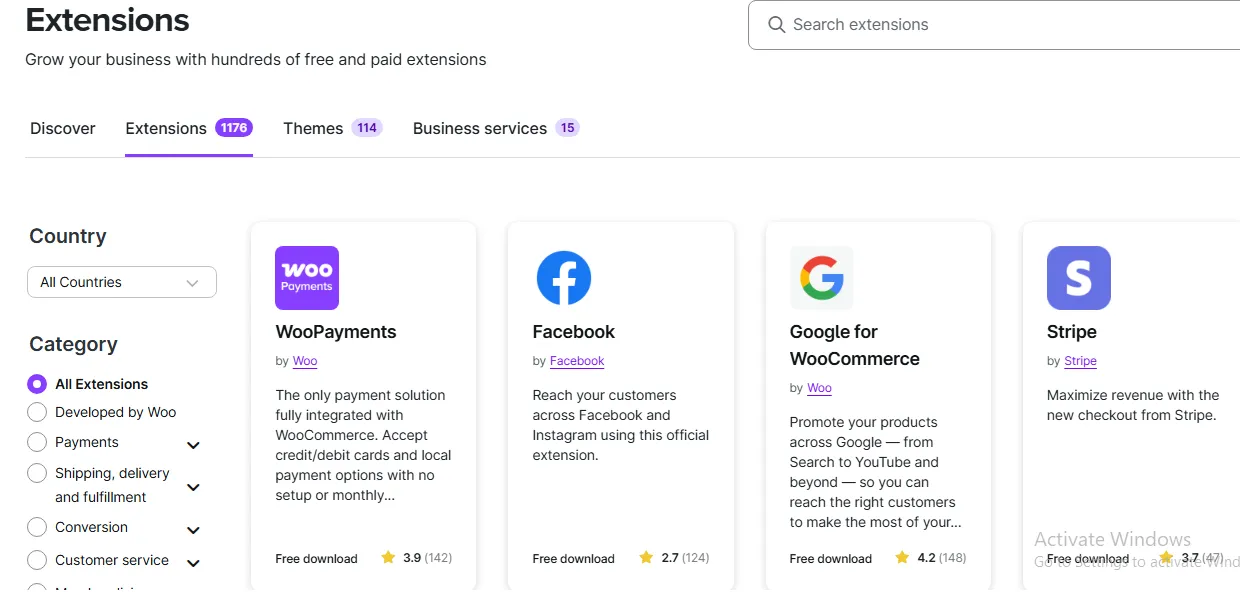
Fortunately, unlike with Zen Cart, each plugin has been vetted for quality. Many are developed by WooCommerce itself or by long-standing partners, which reassures merchants that these tools meet standards for security and reliability. And despite the smaller size, this plugin library still covers virtually every core business need, from connecting CRMs and automating email marketing to managing subscriptions, bookings, shipping, and taxes.
The browsing experience in WooCommerce's marketplace is also designed with merchants in mind. You can filter plugins by:
- Country (to ensure compatibility in your region)
- Category (to quickly narrow down the type of tool you need)
- Price (for free and premium options)
Ratings and reviews also provide additional guidance, helping you see what's working well for other users before you commit.
Hosting Requirements (A tie)
The Verdict
In terms of hosting, both WooCommerce vs Zen Cart end up on equal footing. Neither platform comes with built-in hosting, so merchants are expected to choose and manage their own server environments.
So, as you can see, since the responsibility rests with the user in both cases, hosting is one area where neither platform between WooCommerce vs Zen Cart has a clear advantage:
Zen Cart’s hosting requirements
Zen Cart’s open-source nature gives merchants the freedom to select from their chosen providers. This flexibility is actually quite a strong point, as the software is compatible with most popular names like Bluehost and Hostinger.
For store owners seeking to reduce costs while maintaining solid performance, Zen Cart recommends providers like NodePing, AEIIA, and Digital Ocean, all of which typically cost under $50 per month.
WooCommerce’s hosting requirements
WooCommerce works relatively under the same principle.
Since WooCommerce is a WordPress solution, that means all aspects of the store (from product pages and checkout to order data and customer information) are hosted directly on the same server as your WordPress site. This setup gives you complete control over performance and security, which is appealing to merchants who want to fine-tune every detail. At the same time, it also puts the responsibility on you to ensure that your hosting environment is optimized.
SEO & Marketing (WooCommerce wins)
The Verdict
Since both WooCommerce vs Zen Cart start with only the essentials, store owners must rely on customization and extensions to get real results. However, WooCommerce enjoys a far broader range of options, with more than 200 available plugins (almost double Zen Cart's 130+).
To understand why WooCommerce edges out, let's look more closely at what each one brings to the table in this WooCommerce vs Zen Cart comparison:
Zen Cart's SEO & marketing
At the moment, Zen Cart provides only a limited foundation for SEO.
Store owners are provided with a basic guide to assist with keyword use, alt text, and meta tags; however, there are no built-in features to simplify or automate these processes. So, if you want to go further, you'll need to either work with custom code or turn to third-party plugins!
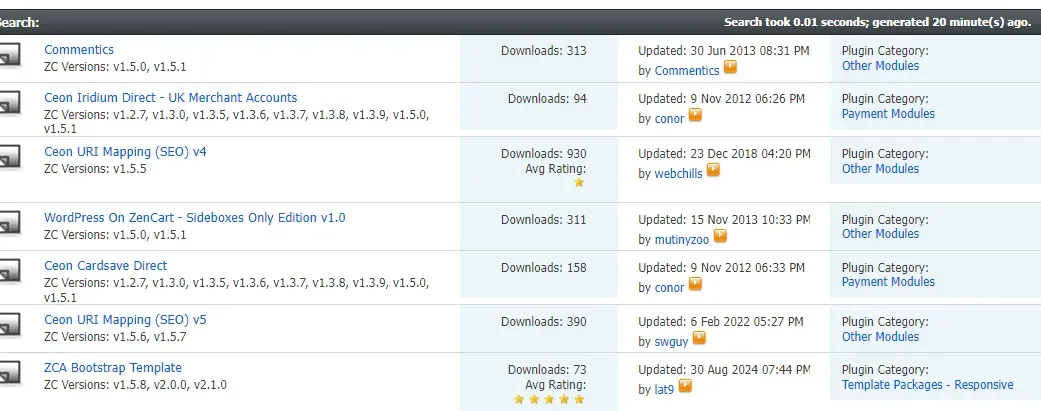
The challenge, however, is that Zen Cart doesn't have a dedicated SEO section in its marketplace. While around 30 free plugins do exist, you'll have to dig them out by typing “SEO” into the search bar and sifting through results scattered across different categories. For newcomers, this lack of structure can be both time-consuming and discouraging.
The story is similar when it comes to marketing. Zen Cart's native functionality extends only to a basic email system that allows bulk sending, checkout message customization, and personalized order updates.
So, as you can see, while helpful for simple communication, such options clearly aren't enough to support more advanced campaigns. To fill the gap, you'll once again need to turn to add-ons.
The platform currently offers about 130 free marketing plugins so far, covering elements like discounts, surveys, social media connections, and even auto-tweet announcements for new products. These options certainly expand the toolkit, but they remain limited compared to what other ecosystems provide.
WooCommerce's SEO & marketing
From our observation, WooCommerce begins from a similar place, with only lightweight SEO and marketing tools built in.
However, its biggest advantage is its deep integration with WordPress. Right away, store owners inherit WordPress's basic SEO structure, such as customizable permalinks and editable meta titles and descriptions. To go beyond that, plugins like Yoast SEO or Rank Math are readily available, allowing your team to add XML sitemaps, schema markup, product-level keyword optimization, and more. The sheer size of the WordPress ecosystem ensures that no matter what level of SEO control you need, there's almost always a reliable plugin to support it!

On the marketing side, WooCommerce also keeps things simple at the core. You can create discount codes, generate basic sales and order reports, and send transactional emails such as confirmations and shipping updates.
But much like with SEO, the real power comes from extensions: with over 200 marketing-related options, WooCommerce almost doubles the offers available on Zen Cart! Long story short, be it recovering abandoned carts, setting up upsell and cross-sell funnels, connecting to email platforms, or running social media campaigns, there's always a plugin for it.
Scalability and Performance (Zen Cart wins)
The Verdict
Between WooCommerce vs Zen Cart, Zen Cart has the upper hand because it gives store owners far more direct control over how the system runs. It allows adjustments at every technical layer, from server setup to database tuning, which means performance can be pushed very far with the right expertise.
Still, WooCommerce is easier to scale and optimize for most small to medium-sized stores. To understand more about how WooCommerce vs Zen Cart perform, let’s look at them more closely here:
Zen Cart’s scalability and performance
As one can guess, Zen Cart easily stands out because it places control directly in the hands of the user. Since the platform is both open-source and self-hosted, you are free to configure the server environment, caching methods, and database management in whatever way best suits your store!
Needless to say, for those with the technical know-how, this advantage makes Zen Cart extremely adaptable. With the right setup, it can process an extremely extensive catalog of products and manage heavy transaction volumes while maintaining stability.
Still, keep in mind this potential does not come effortlessly; scaling Zen Cart requires consistent hands-on work to keep everything optimized. Server settings must be fine-tuned, caching must be managed carefully, and databases need to be regularly maintained. And worse, unlike WooCommerce, Zen Cart doesn’t offer that many built-in tools to simplify this process!
In other words, while its ceiling for scalability is very high, reaching that level depends heavily on the technical skills and resources you bring to the platform.
WooCommerce’s scalability and performance
Meanwhile, WooCommerce mostly leans on the power of the WordPress ecosystem. With access to quality hosting, caching solutions, CDNs, and a wide array of optimization plugins, a WooCommerce store can grow from a small operation into a fairly large, traffic-heavy site. Tools for object caching, lazy loading, and image optimization are also easy to integrate, so it's possible to keep performance steady as demand increases.
Nevertheless, the challenge is that WooCommerce’s performance is only as strong as the components it relies on. Poorly coded plugins, bloated themes, or an unoptimized database can quickly cause slowdowns, particularly when traffic spikes!
Not to mention, as the store expands with more products, variants, and orders, the database itself can become heavy and hinder essential tasks (like search or reporting) noticeably slower without careful optimization. Such obstacles create an ongoing need for maintenance as a result, including regular updates to WordPress, WooCommerce, and all installed plugins, along with constant performance tuning.
Security (WooCommerce wins)
The Verdict
Thanks to diverse available solutions and an active security community that continually monitors for threats, WooCommerce offers store owners a more reliable safety net. Meanwhile, Zen Cart does include important protective measures, but the burden of managing them falls squarely on the user.
This difference between WooCommerce vs Zen Cart explains why WooCommerce is generally the safer choice in practice. Let’s look more closely at how each platform handles security!
Zen Cart’s security
Overall, Zen Cart covers the fundamentals: it supports SSL encryption, integrates with secure payment gateways, and provides options for admin access control and logging.

The platform also issues guidance on how merchants can secure their stores and apply updates as needed. Not to mention, since Zen Cart is less widely used than WooCommerce, it is not as frequently targeted by large-scale automated attacks. In some ways, this lower profile helps reduce exposure to mass exploits that commonly affect WordPress sites.
Still, the real test of Zen Cart’s security lies in the store owner’s ability to manage it. Keeping a Zen Cart site safe requires constant attention, including patching code, configuring servers, maintaining strict file permissions, and ensuring hosting environments are hardened.
Hence, for those without strong technical skills or a dedicated IT team, it’s easy for vulnerabilities to slip through. On top of this, Zen Cart’s update cycle tends to be slower, as its patches arrive much less often than those in larger ecosystems.
WooCommerce’s security
WooCommerce, on the other hand, faces a different challenge altogether: its sheer popularity makes it a frequent target for hackers.
Nevertheless, this same popularity also ensures that it benefits from a vast network of protections. The WordPress ecosystem provides well-established practices for securing sites, along with a broad selection of plugins and services designed specifically to combat threats. Likewise, from SSL certificates and secure payment gateways to malware scanners, firewalls, and intrusion detection, WooCommerce users have no shortage of tools at their disposal.
And just as important is the support system around WooCommerce. Many hosting providers build specialized environments to harden WordPress and WooCommerce stores, and plugin and theme developers often adhere to recognized security standards.
Regular updates from WooCommerce itself, combined with WordPress’s dedicated security team, mean that vulnerabilities are usually identified and patched quickly. This ongoing cycle of monitoring, auditing, and improvement gives WooCommerce powerful protection that goes beyond what smaller ecosystems can easily provide.

Support and Community (WooCommerce wins)
The Verdict
Between WooCommerce vs Zen Cart, WooCommerce comes out ahead in terms of customer support simply because it provides more options for users to turn to. That said, both platforms still leave plenty of room for improvement.
The following section will give you a closer look at how WooCommerce vs Zen Cart compare.
Zen Cart's customer support
Zen Cart, unfortunately, offers very little in the way of official support.
If you were hoping for direct contact options like phone assistance or live chat, you won't find them here. Instead, the platform relies almost entirely on its documentation and a community forum where users try to help one another.

Sure, these resources can sometimes provide answers, but they clearly fall short when you need immediate or expert guidance. Long story short, for many store owners, especially those new to eCommerce, the support experience on Zen Cart feels limited and frustrating.
WooCommerce's customer support
From our observation, WooCommerce's documentation is extensive, covering everything from getting started guides to advanced developer notes. Not to mention, beyond the official materials, there's also a vast network of forums, Facebook groups, and third-party communities where discussions are active and solutions are widely shared.

Still, to our disappointment, direct, personalized support is only available if you purchase a premium extension through WooCommerce.com, which grants you access to ticket-based assistance. For most users, the primary support channels remain self-service guides and community discussions.
The one notable exception is that newcomers can fill out a form to be matched with a WooCommerce consultant who offers initial setup guidance. Other than that, the ongoing support experience remains largely self-directed.
Pricing (WooCommerce wins)
The Verdict
Lastly, when comparing WooCommerce vs Zen Cart pricing, WooCommerce generally offers more flexibility and value, especially for businesses that want to scale gradually.
Want to know why we came up with this conclusion for the WooCommerce vs Zen Cart comparison? Take a look!
Zen Cart’s pricing
Zen Cart’s biggest advantage is that it’s completely open source, which means you can download and install it without paying a licensing fee. That low entry barrier makes it appealing for anyone who wants to start selling online without upfront software costs.
However, once the store is live, the expenses start to add up:
- Hosting alone can range from about $2 to $35 per month, depending on server capacity and traffic.
- A theme may cost nothing if you use a basic option, or up to $50 one time for a more polished design.
- Extensions often fall between free and $25 per month.
- To boost visibility, SEO services can cost around $50 monthly
- Ongoing maintenance for updates and bug fixes averages around $200 per month.
- Security solutions, such as audits or protection tools, add about $200 annually.
Taken together, these expenses mean a typical Zen Cart store will run somewhere between $824 and $3,920 per year, depending on how many extras you decide to invest in.
WooCommerce’s pricing
WooCommerce follows a similar pattern: the core plugin itself is free, but additional costs are inevitable if you want a professional, fully functional store:
- Hosting usually starts at around $3 per month for shared plans, but can climb to $500 per year or more for managed WooCommerce hosting.
- You’ll need a domain name, which costs about $10–20 annually, and potentially a premium theme, which can range from $20 to $100 per year depending on the design.
- Extensions for memberships, subscriptions, or advanced shipping often require paid plugins, which add anywhere from a few hundred to over a thousand dollars each year.
- Security also carries a cost, with SSL certificates, malware scanning, and backup solutions averaging around $250 annually.
The final bill varies widely, but a moderate store with basic needs might get by with $50–$1,000 annually.
Can You Migrate from Zen Cart to WooCommerce or Vice Versa?
Yes, migration between Zen Cart and WooCommerce is absolutely possible! After all, businesses often outgrow one platform and need to switch to the other to better align with their growth goals and ecosystem needs.
And the good news is that you don't have to manually move every piêc of data; leading migration services like LitExtension make the process smooth and reliable. We offer two main packages:
- Automated Migration: a fast, hands-off tool for those who want to take control of their own data migration. You can transfer products, customers, orders, categories, and more securely with minimal downtime.
- All-in-One Migration: a much more comprehensive package where LitExtension's experts handle the entire process for you, including customizations, troubleshooting, and post-migration support. All you have to do is sit back and wait for our updates!
With either option, the goal is to ensure your business transitions seamlessly while preserving data integrity. So don't wait; contact us now for more consultation.
Need Help To Migrate to WooCommerce?
LitExtension provides a well-optimized All-in-One migration service for your data transfer!

WooCommerce vs Zen Cart: FAQs
What is the difference between Zen Cart and WooCommerce?
Zen Cart is a standalone, open-source shopping cart platform focused on technical customization and server-level control. WooCommerce, by contrast, is a plugin built for WordPress, which makes it easier to install, use, and expand through WordPress’s massive ecosystem of plugins and themes.
What are the cons of WooCommerce?
WooCommerce is beginner-friendly, but it depends heavily on plugins for advanced features, which can raise costs and complicate maintenance. Its performance is also sensitive to plugin quality and hosting choices, so poorly managed setups may run into speed or stability issues.
Is WooCommerce still relevant?
Absolutely. WooCommerce remains one of the most popular eCommerce solutions worldwide. Its constant updates, vast plugin ecosystem, and integration with WordPress ensure that it continues to meet the needs of modern online businesses in 2025 and beyond.
Final Verdict: Which One Should You Choose?
We all agree that WooCommerce is the stronger all-rounder for many merchants, but that doesn't mean that Zen Cart is not a solid solution. At the end of the day, the best choice depends on the size of your business, your goals, and especially the level of technical expertise you have access to.
So, choose WooCommerce if you are:
- A small to medium-sized business looking for an easy-to-use platform with quick setup and plenty of growth potential.
- An entrepreneur or startup owner who wants to leverage WordPress integration for blogging, SEO, and content-driven growth.
- A growing brand that values flexibility through vetted extensions and professional-looking themes without heavy coding.
- A larger business that prefers scalable hosting solutions and modern integrations but doesn't want to rely too much on manual development.
And choose Zen Cart if you are:
- A technically proficient business or one with an in-house development team that can handle coding, server configuration, and ongoing optimization.
- A retailer managing a large inventory that requires complex stock or shipping configurations beyond what plug-and-play solutions provide.
- A business that prioritizes deep control over every aspect of the store, even if it means investing more time in setup and maintenance.
- An organization comfortable with a steeper learning curve in exchange for higher scalability potential.
For more tips, check out our WooCommerce guide or join our Facebook Community.

